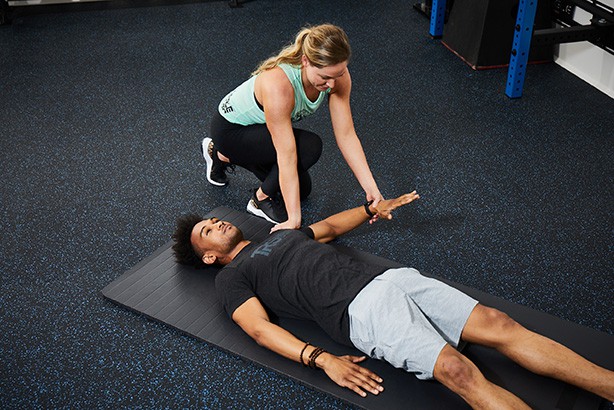Over 50? You Don’t Have To Be Achy and Stiff!
Remember that time in your life when there were no boundaries and limits on what you could do? And no, I’m not referring to freely leaving your house without PPE to make a Target run or to get that workout sesh in at the gym. What I’m talking about is the last time you were able to jump out of bed without feeling like your joints articulated like LEGO blocks. Whether this time existed while you were in your 40’s, 30’s, 20’s or even, teenage years; this was a period of time that you may remember feeling invincible and at the peak of your vitality.
Aging without a doubt is inevitable. Father Time is undefeated. But one thing that’s perplexing about aging is how many quinquagenarians (50 somethings) are quick to accept or cling to the notion that suffering from aches and pains is the norm; as if the wounds and patina of the miles accumulated on our bodies is a badge of honor, irreversible or even worse, an acceptable excuse to play the” back nine” with merely a putter.

As it turns out, living a care-free, high-performance and pain-free existence can feel pretty out of reach these days, even before stay at home orders were put into place. Rather than dwell on what we can’t do from our former years, it’s time to celebrate what we can still do so we can continue to fulfill our ikigai. So for the upper ⅓ of you Gen X’ers, half-centurions, or old souls out there, here is a list of actionable steps that you can take to flip the switch on that stiff and achy body that’s uniquely yours.
YOU ARE WHAT YOU DO & DON’T EAT
You may be thinking … wait a sec, you’re a physical therapist, so why is the first thing you recommend to help my aching body, nutrition? The same reason why six-pack abs are made in the kitchen and not in the gym. If you were recovering from surgery, would you heal faster if you ate chocolate donuts and Powerbars, or would you heal faster-eating nutrient-dense foods that consist of high-quality meats and vegetables? What you choose to eat has to support healthy cell function, regeneration, and fight inflammation.
There is a compound called glycosaminoglycans (GAGs), which occupy the role of keeping our joints lubricated, connective tissue elastic and help remodel new & healthy tissue. Collagen, hyaluronic acid, and glucosamine all fall into this category and are components found in common over the counter joint health remedies and conservative orthopedic treatment options. With aging, the natural production of GAGs decreases so we must find a way to supplement this drop-off. Foods that are rich in collagen such as bone broth or cooking meat on the bone are ways to supplement.
The oils that we choose to cook our food also need to be looked at. Vegetable oils or polyunsaturated fats (which are commonly found in processed food) disrupt how well blood flows and circulates, which is critical in creating an optimal environment for healthy cell function, growth, and performance. Instead of cooking with man-made vegetable or canola oil, opt to cook with coconut oil, olive oil, or butter. This list below is a useful guide on good fats versus bad fats, courtesy of Deep Nutrition author Dr. Cate Shanahan.

The foods we choose to eat should not be inflammatory in nature. Let me clarify, the food we choose to eat should not be inflammatory to you. Most, if not all diseases, stem from chronic levels of inflammation. This is no different for achy and stiff joints. Food or supplements which are high in Omega 3 fats such as grass-fed meats or fish oils have been shown to decrease joint inflammation but start to identify what foods trigger inflammation in you.
If you find yourself frequently reaching for the Advil or NSAIDs, wait. Curcumin (the active ingredient in Turmeric) may be a better alternative, not only because it is natural and found to be an effective remedy for joint-related pain. It’s also because curcumin won’t inhibit protein synthesis (aka – tissue building) the way NSAIDs will.
50 IS THE NEW 35 ANYWAY – ISN’T IT?
Unless you grew up tending to the family farm or had to hunt and gather your food like your life depended upon it, the rest of us have grown up with a life of convenience and never had the demand to “use” our bodies the way our ancestors did. In our modern lives, the volume of exposures that our joints, muscles, and bones have been subjected to movement and load, are significantly lower. Our bodies are actually not as beat up as we perceive it is, although that aching knee or lower back might leave you feeling otherwise. It’s not the high-mileage running that wore out the cartilage in your knee that now has you limping around each time you rise from your chair or the military presses that caused your arm to ache each time you reach for something overhead. It’s the progressively sedentary and less physically demanding lifestyles we adopted that have put us in this, as Erwan le Corre would call it, Movement Poverty Predicament.
MOTION IS LOTION
Not to beat a dead horse, but a sedentary lifestyle is no Bueno. According to the CDC, more than 1 out of 4 adults older than 50, are considered inactive, which is defined as, no activity beyond baseline activities of daily living. To put that into perspective, that roughly equates to 31 million people, which is greater than the number of people that have currently filed for unemployment in the United States amidst this pandemic.
Here’s what results from inactivity at a physiological level:
- Sarcopenia – which is a loss of muscle mass that begins to take place in our 30’s. Physically inactive people can lose 3-5% of muscle mass each decade after the age of 30
- Decrease in production of GAGs
- Decrease in bone density
Not to mention the drag it places on our emotional well being.

BREAK THE CYCLE
Instead of recommending particular movement practices or fitness regimens, I encourage you to take yourself through a movement audit. When was the last time you got on/off the floor, ran, threw something, jumped, climbed, swam or played? Just a few activities to name those brilliant thinkers like Mark Sisson and Katy Bowman would agree upon that are essential to break the M-OLD.
If the thought of that seems daunting, then start with walking more.
To get the desired adaptations, you have to stress all of your systems – muscularly, aerobically, and cognitively. Breathe hard(er), move fast(er), lift/push something heavy(er), and learn a new skill. Enjoy it every step of the way. There’s no cookie-cutter way to achieve this thing called aging sav-AGE-ly.
Oh yeah, and then there’s this thing called Mobility. Work on it.
Stop drifting…Sprint to the finish. Write off your hopes, and if your well-being matters to you, be your own savior while you can.
~ Marcus Aurelius
(For more about aging, check out Season 5 of The Ready State Podcast)



















TRS Virtual Mobility Coach
Guided mobilization videos customized for your body and lifestyle.
FREE 7-Day Trial